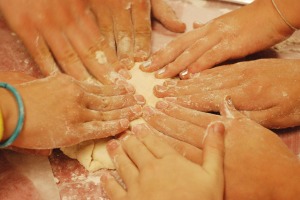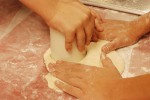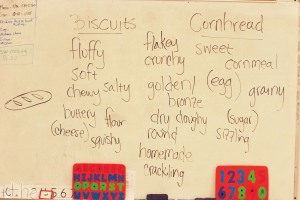This amazing guest post is from Ariel Wilson, who contacted me after reading ‘French Kids Eat Everything’. As it turns out, Ariel is also connecting food cultures-in her case, through teaching at schools in both the US and France! Read on to find out more about the amazing lessons her students learn through her virtual ‘potlucks’, and to learn more about Ariel’s ‘Global Potluck’ vision (with a bonus of two fun recipes to try with kids!). Thanks Ariel for your dedication and inspiring ideas!
“Woah, Ms. Wilson – you mean to tell me that there are anywhere from 400 to 1000 different kinds of cheese in France?” Normally, I discourage my students from interrupting a lesson without raising their hand. After noticing that this student had a fork full of the warm “King Cake” that we had just prepared in one hand, and a crumpled napkin in the other, I let the engaged student finish his thought: “Well, that’s pretty cool!”
That day, I visited my younger sister’s fifth grade class in my hometown of Bakersville, North Carolina to teach a lesson on French cheese (Epoisses, specifically). I was fresh off the plane from Semur-en-Auxois, France, where I had been teaching primary school students for seven months.
While there, my students, fellow teachers, and I had wanted to do the fairly normal activity of writing to an English-speaking class. In an attempt to make this correspondence more meaningful than just posing simple and predictable questions though, we decided to exchange traditional recipes and food anecdotes while learning the corresponding vocabulary. (I’ve included some of our recipes below.)
The result has been a delicious success!
Since our Global Potluck correspondence began nearly a year ago, my French students and their North Carolina pen pals have had the opportunity to participate in concrete and authentic cultural experiences without leaving the classroom.
My students in rural Burgundy discovered that “barbecue” is both a noun and a verb in the Southeast United States, while students in southern Appalachia learned why little figurines are hidden and baked into Epiphany season “King Cake,” or “la galette des rois.”
What’s even more fun is that we were able to prepare our recipes in class to taste the differences, and (surprisingly) oftentimes the similarities between our two cultures!
Perhaps one of the most rewarding results of this edible dialogue has been witnessing how these encounters both change and inspire students’ previous ideas about food. In sharing a food tradition that is important to them, they are more open to receiving and understanding unfamiliar food traditions from their correspondents. For example, there was hardly any need to establish a “No Ew!” rule for either my French or American students. Instead, they are oftentimes prompted to share creative preparations of their own recipes, as well as eager to take home a copy of their pen pal’s recipe. As one of my fifth graders said, “It’s too bad that Epoisses cheese is so hard to find [in Bakersville]; it looks so good, I would take it home and eat some for supper tonight if I could!”
The most recent installment of Global Potluck on cornbread and biscuits comes from students in North Carolina. See below for some of the students’ family recipes, as well as photos of us preparing biscuits in class. To see more posts in our correspondence, as well as to find out how to participate, please visit us on the Zomppa webpage!
Bon appétit, y’all !
Global Potluck Cornbread Recipe
2 cups self-rising cornmeal
1 cup milk
1 egg
2 tablespoons oil or butter, melted
Mix all ingredients together. Pour in pan with oil. Bake at 350 for 30 minutes or until done and well browned on top.
Global Potluck ‘Daddy’s Biscuits’ Recipe
2 cups all-purpose flour
3 teaspoons baking powder
1 teaspoon salt
6 tablespoons butter or lard (cold)
2/3 to ¾ cup whole buttermilk
1. Preheat oven to 500 degrees Fahrenheit.
2. In a large bowl, sift flour, baking powder, and salt together.
3. Using a pastry cutter or two knives, cut cold butter into flour mixture until pieces of butter are smaller than a pea. Or use your fingers to incorporate the butter.
4. Add 2/3-cup buttermilk. Stir in with as few strokes as possible until dough leaves the sides of the bowl. Add additional buttermilk if necessary to achieve this. (If you work the dough too much, your biscuits will be tough instead of light and fluffy.)
5. With floured hand, for dough into a loose ball and turn on to a floured surface.
6. Knead once or twice.
7. Roll dough out to 5/8 inch thick.
8. With a floured biscuit cutter or the rim of a small glass, cut dough into 2’ rounds and place onto a heavy baking sheet with sides of biscuits touching.
9. Bake 8-10 minutes or until tops of biscuits turn golden.
10. Remove from oven and rub tops of biscuits with a stick of butter and wrap in a towel.
Makes 8-10 biscuits.
Tip #1: Mix, knead, and roll dough absolutely as little as possible to get a fluffy, light biscuit.
Tip #2: If you use your fingers to cut the butter into flour, do so quickly so that your body heat doesn’t melt the butter.






That is such a great initiative! I love the “no Ew” rule 🙂
LikeLike